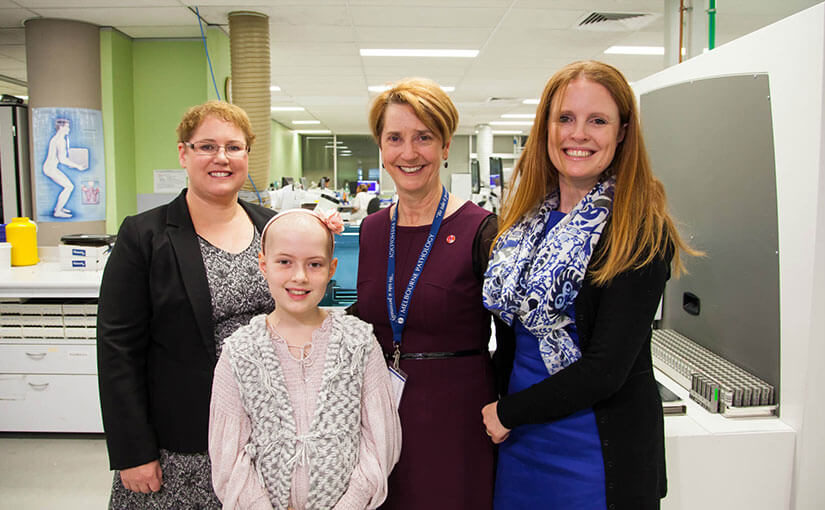A year ago this week, Stephen Veneris was settling in for a night of football on the TV when he received a devastating phone call about his daughter.
Eight-year old Bridgette had been diagnosed with Leukaemia and without immediate medical attention her life was at risk.
Yesterday, Bridgette and her Mum Sharon met the team who made the diagnosis and then that life-changing phone call, including Haematologist Dr Ellen Maxwell. The meeting was inspired from Bridgette’s determination to help others by becoming a Haematologist when she grows up.
Director of Haematology Dr Maxwell was joined by fellow Haematologist and cancer researcher Dr Kylie Mason. Kylie had the same type of Leukaemia as Bridgette when she was a child and her career proves Bridgette’s dream could become reality.
Dr Maxwell and Dr Mason showed Bridgette the very blood sample that revealed her diagnosis down a microscope. Bridgette could see the cancer cells in her blood stream back then and compared the sample to a more recent, healthier blood test. They also walked her through a day in the life of a working haematology laboratory.
Pathology is responsible for 100% of cancer diagnoses. Haematology is the pathology department that deals with blood cancers such as leukaemia. Doctors rely heavily on test results to help plan treatment and minimise side effects.
Last winter Bridgette’s Mum Sharon had been concerned at how tired her daughter had been. A trip to the doctor led to some bloods being drawn after school, followed by a Friday dinner out with a school friend who was going to stay over.
Meanwhile at the laboratory, Bridgette’s full blood count results were causing concern among pathology staff. Her haemoglobin was so low that her organs weren’t getting all the oxygen they needed. Her platelets were also low and if she suffered a cut her body could have struggled to stop the bleeding. In fact, Bridgette was already getting a lot of large bruises. Her ability to fight off simple infections was seriously hampered by an extremely poor white blood count (immune system cells).
By 6:15pm, Scientists and a Pathologist had looked at Bridgette’s blood cells down a microscope and diagnosed the cause of the life-threatening results – acute lymphoblastic leukaemia.
After exhausting all avenues of communicating with Bridgette’s family doctor, the Pathologist rang Stephen directly and asked him to drive Bridgette straight to Monash Hospital for a blood transfusion. The Pathologist then rang Monash and helped them prioritise Bridgette upon arrival. The hospital staff confirmed the diagnosis.
Both Stephen and Sharon were shocked by the phone call but ultimately grateful.
Bridgette has since bravely endured chemotherapy and still has a further 18-24 months to go. Her experience has made her want to help others in her situation but her interest in science pre-dates her diagnosis. The previous Christmas, Bridgette had asked for a microscope. After opening it, she’d even asked her Dad to prick his finger so she could see the blood cells down the lens.
It was Pathology Awareness Australia’s great pleasure to help coordinate this event for Bridgette and her Mum, Sharon. At just nine years of age, Bridgette was able to name the types of blood cells she could see in the samples, a feat Medical Scientists and Pathologists usually learn at university!

